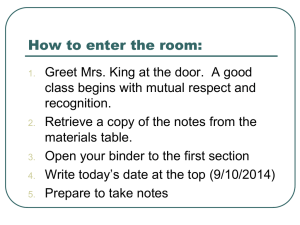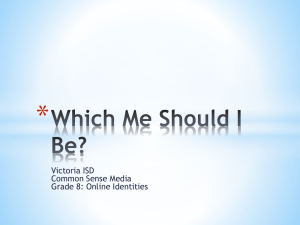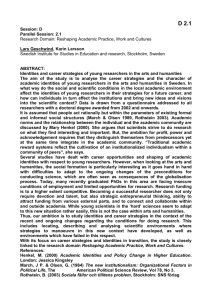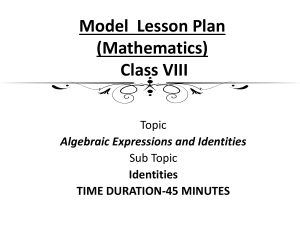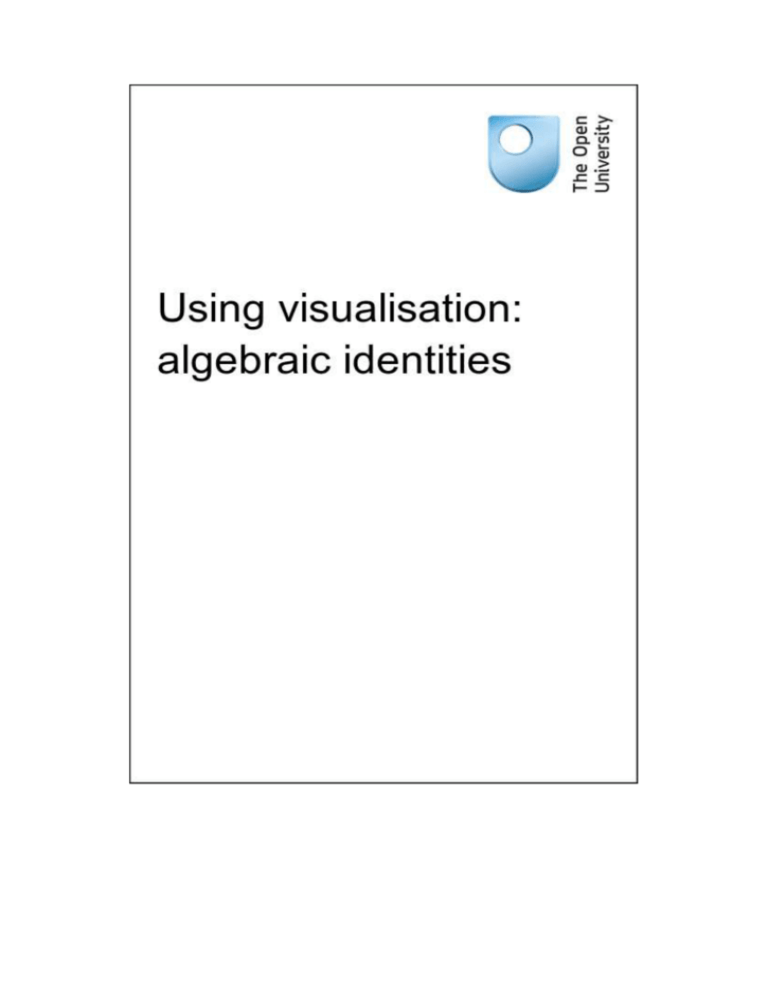
Using visualisation: algebraic identities TI-AIE
TI-AIE Secondary Maths
TI-AIE
Using visualisation: algebraic identities
Page 2 of 24
http://www.open.edu/openlearnworks/course/view.php?id=1911
27th May 2015
Using visualisation: algebraic identities TI-AIE
This publication forms part of the Open University module [module code and title].
[The complete list of texts which make up this module can be found at the back
(where applicable)]. Details of this and other Open University modules can be
obtained from the Student Registration and Enquiry Service, The Open University,
PO Box 197, Milton Keynes MK7 6BJ, United Kingdom (tel. +44 (0)845 300 60 90;
email general-enquiries@open.ac.uk).
Alternatively, you may visit the Open University website at www.open.ac.uk where
you can learn more about the wide range of modules and packs offered at all levels by
The Open University.
To purchase a selection of Open University materials visit www.ouw.co.uk, or contact
Open University Worldwide, Walton Hall, Milton Keynes MK7 6AA, United
Kingdom for a catalogue (tel. +44 (0) 1908 274066; fax +44 (0)1908 858787; email
ouw-customer-services@open.ac.uk).
The Open University,
Walton Hall, Milton Keynes
MK7 6AA
First published 200X. [Second edition 200Y. Third edition ....] [Reprinted 200Z]
Copyright © 200X, 200Y The Open University
All rights reserved. No part of this publication may be reproduced, stored in a
retrieval system, transmitted or utilised in any form or by any means, electronic,
mechanical, photocopying, recording or otherwise, without written permission from
the publisher or a licence from the Copyright Licensing Agency Ltd. Details of such
licences (for reprographic reproduction) may be obtained from the Copyright
Licensing Agency Ltd, Saffron House, 6–10 Kirby Street, London EC1N 8TS
(website www.cla.co.uk).
Open University materials may also be made available in electronic formats for use
by students of the University. All rights, including copyright and related rights and
database rights, in electronic materials and their contents are owned by or licensed to
The Open University, or otherwise used by The Open University as permitted by
applicable law.
In using electronic materials and their contents you agree that your use will be solely
for the purposes of following an Open University course of study or otherwise as
licensed by The Open University or its assigns.
Except as permitted above you undertake not to copy, store in any medium (including
electronic storage or use in a website), distribute, transmit or retransmit, broadcast,
modify or show in public such electronic materials in whole or in part without the
prior written consent of The Open University or in accordance with the Copyright,
Designs and Patents Act 1988.
Page 3 of 24
http://www.open.edu/openlearnworks/course/view.php?id=1911
27th May 2015
Using visualisation: algebraic identities TI-AIE
Edited and designed by The Open University.
Printed and bound in the United Kingdom by [name and address of printer].
ISBN XXX X XXXX XXXX X
X.X
Page 4 of 24
http://www.open.edu/openlearnworks/course/view.php?id=1911
27th May 2015
Using visualisation: algebraic identities TI-AIE
Contents
What this unit is about
What you can learn in this unit
1 Learning through memorisation
2 Visualisation for developing understanding of algebraic identities
3 Algebraic identities seen as special cases of multiplication
4 Spotting patterns and adjusting algebraic identities
5 Summary
Resources
Resource 1: NCF/NCFTE teaching requirements
Additional resources
References
Acknowledgements
Page 5 of 24
http://www.open.edu/openlearnworks/course/view.php?id=1911
27th May 2015
Using visualisation: algebraic identities TI-AIE
What this unit is about
Algebraic identities play an important role in the mathematics curriculum and in
mathematics in general. In Class IX in the Indian secondary school curriculum, eight
types of identities are used when solving equations and polynomials. Knowing and
recognising these identities helps students to learn mathematical procedures. It will
also enable them to develop fluency when applying these procedures in algebraic
manipulations and problem solving. In order to use the power of identities fully, it is
important to be able to spot variations in the algebraic identities. The main issue when
learning and applying identities is that, for most students, the work is purely a
question of memorising and regurgitating them.
This unit will explore some different approaches using visual representation that you
can use with your students to help them learn algebraic identities. These approaches
rely less on memorisation and instead build on understanding the concepts of
identities.
Page 6 of 24
http://www.open.edu/openlearnworks/course/view.php?id=1911
27th May 2015
Using visualisation: algebraic identities TI-AIE
What you can learn in this unit
How to use images to help your students explore and discover how
identities are formed.
Some ideas on how to use and apply identities without having to rely
on memory.
How to adjust existing tasks to allow your students to focus on the
process of doing mathematics.
This unit links to the teaching requirements of the NCF (2005) and NCFTE (2009)
outlined in Resource 1.
Page 7 of 24
http://www.open.edu/openlearnworks/course/view.php?id=1911
27th May 2015
Using visualisation: algebraic identities TI-AIE
1 Learning through memorisation
Learning through memorisation, or rote learning, is a learning technique based on
repetition.
There are several arguments in favour of this learning approach: one is that having a
rapid recall of certain facts in mathematics is necessary to become fluent in other
mathematics topics.
Many students are encouraged to learn their ‘times tables’ by rote. This is so that
when they are solving problems they do not spend too much time and effort working
out relatively simple calculations such as 6 x 7 – especially when they have no access
to calculators. Knowing times tables by heart also gives them a better number sense;
for example, of the numbers’ magnitude, of how numbers are related or of multiples
and fractions. Similar arguments could be used for learning algebraic identities
through memorisation.
However, there are also many counter-arguments to using memorisation as a learning
technique (De Morgan, 1865; Marton and Booth, 1997). One is about accessibility;
not all students benefit from memorisation due to their poor school attendance, their
lack of time or opportunity for the required practice, or just their poor recall. Students
with special educational needs such as dyslexia, for example, are enormously
disadvantaged.
Another argument concerns the kind of learning that memorisation affords.
Memorisation does not focus on comprehension or building understanding; nor does it
support any exploration of what concepts could mean, or how they are connected to
other areas of mathematics. It focuses on memorising and accurate reproduction,
which can become problematic when studying more complex aspects of a subject
(such as formulae and algorithms) that entail many steps. Memorisation does not lead
to understanding of meaning, which means that elements get missed out, details get
muddled up, stress increases and exams can be failed.
The learning experience when using memorisation is often not exciting; it can even be
considered boring because of its repetitive nature and lack of focus on understanding
and making connections. Students mechanically ‘go through’ the exercises, engaging
their brains as little as possible. This is problematic for all students, including high
achievers. Boredom when learning mathematics, little demand for thinking and a lack
of opportunity to work on making connections and giving meaning to mathematics
makes it hard for learners to understand and enjoy the subject.
Page 8 of 24
http://www.open.edu/openlearnworks/course/view.php?id=1911
27th May 2015
Using visualisation: algebraic identities TI-AIE
Pause for thought
What are your thoughts about learning through memorisation? Do you
think it works well always, sometimes or not often?
How did you experience learning mathematics by memorisation?
Think of one of your students who seems to be memorising well, and
think of one that is struggling. What is the same and what is different
about how they learn?
Page 9 of 24
http://www.open.edu/openlearnworks/course/view.php?id=1911
27th May 2015
Using visualisation: algebraic identities TI-AIE
2 Visualisation for developing understanding of
algebraic identities
An effective way to rely less on memory for learning is through the use of
visualisation. Visualisation means seeing an image of something in your mind.
Different people will not always ‘see’ things in the same way, but ‘visual thinking’ is
very important to the construction of understanding by your students (Dörfler, 1991).
Visualisation can be introduced with relatively simple operations. For example,
multiplication can be represented as a product table that is similar to area. (There are
other ways to represent multiplication.)
The product 7 × 3 can be represented by an area of seven by three squares (Figure 1).
From this image it is also clear that multiplication is commutative – that is, the
product of 7 × 3 is the same area as the product of 3 × 7.
Figure 1 A product table for the sum 7 × 3.
So 7 × 3 is equivalent to 3 × 7 is equivalent to 21. This can be written as:
7 × 3 ~ 3 × 7 ~ 21
Modelling multiplication can help your students to understand a multiplication
problem, because the area of a large rectangle can be easily decomposed into areas of
smaller rectangles. It is good practice not to draw the area models in proportion to the
numbers used: it stimulates more abstract representations and makes the mental jump
to representing negative numbers less difficult. Because it is not possible to have a
negative area, this kind of representation is referred to as a ‘product table’.
For example, 24 × 13 can be represented by the product table in Figure 2. Hence 24 ×
13 ~ (20 + 4) × (10 + 3) ~ 200 + 40 + 60 + 12 ~ 312.
Page 10 of 24
http://www.open.edu/openlearnworks/course/view.php?id=1911
27th May 2015
Using visualisation: algebraic identities TI-AIE
Figure 2 A product table for the sum 24 × 13.
In another example, 192 can be represented by the product table in Figure 3. Hence
192 ~ (20 - 1) × (20 - 1) ~ 400 - 20 - 20 + 1 ~ 361.
Figure 3 A product table for the sum 192.
This decomposition model is very helpful for finding products of larger numbers or
for multiplication involving algebra. A simple example involving algebra is 3(a - b),
as shown in Figure 4. Hence 3(a - b) ~ 3a - 3b.
Figure 4 A product table for 3(a – b).
You might have noticed that in these examples the equivalence sign (~) has
sometimes been used instead of the equals sign (=), which would be equally valid.
Page 11 of 24
http://www.open.edu/openlearnworks/course/view.php?id=1911
27th May 2015
Using visualisation: algebraic identities TI-AIE
The equivalence sign can offer a certain freedom, playfulness to mathematics, in
particular if the sign is read as ‘is another way of saying’ instead of ‘is equivalent to’.
Activity 1 will support students in working with visualisation by seeing multiplication
as a product table. Before attempting to use the activities in this unit with your
students, it would be a good idea to complete all (or at least part) of the activities
yourself. It would be even better if you could try them out with a colleague, because
that will help you when you reflect on the experience.
Trying the activities yourself will mean you get insights into learners’ experiences
that can in turn influence your teaching and your experiences as a teacher. When you
are ready, read Case Study 1 and use the activities with your students. After the
lesson, think about the way that the activity went and the learning that happened. This
will help you to develop a more learner-focused teaching environment.
Activity 1: Making product tables
Tell your students how to construct product tables modelling a number of examples.
You can use ideas from Case Study 1 (below) to help you.
Then write these problems on the board:
(105)2
(14.3)2
4(99)
982
7(t + r)
(r + q)(s - r)
For each of these problems, ask your students to work in pairs to:
a. model the problem as a product table
b. if appropriate, decompose the area into smaller areas
c. work out the products of these calculations by using your answers to
(a) and (b).
After the lesson, use the prompts in the ‘Pause for thought’ box below to help you
evaluate your teaching in the lesson.
Case Study 1: Mrs Aparajeeta reflects on using Activity 1
This is the account of a teacher who tried Activity 1 with her secondary students.
Before starting on this activity we had a discussion on how a number that is squared
or multiplied could be represented by an area model, mimicking the way I learned it
from reading this unit. I started with small numbers like 5 x 6 and then to bigger
numbers like 56 × 64 and 65 × 115. Anup thought of using the distributive property
Page 12 of 24
http://www.open.edu/openlearnworks/course/view.php?id=1911
27th May 2015
Using visualisation: algebraic identities TI-AIE
for the question 65 × 115 = 65(100 + 10 + 5), and so he went ahead and represented it
as a one-by-two table [Figure 5].
Figure 5 A product table for the sum 65 × 115.
We then tried the other multiplication problems. They worked on this mainly on their
own, although every now and then I could see students looking at their neighbour’s
work. They could do most of them well. With the decimal question, most of them
distributed it as 14 + 0.3. I asked them if they felt it was now simpler and some of
them said that it was not, so I told them that they could think of a further
decomposition to make a three-by-three table.
When they came to 982, the ones who decided on 90 + 8 had no problems, but one of
them decided to represent it as 100 - 2 so then he wanted to know how an area could
be negative. This led to a lively discussion about representation and modelling in
mathematics and why it can be helpful to come up with different labels. In this case,
the difference and sameness between a product table and an area representation. We
conjectured that the product table and the area representation would be identical when
working with positive numbers, but you would have problems with negative numbers
in the area model because a negative area does not actually exist. However, we know
a product can be negative, so that is why we would call it a product table!
I did not go deeper into the 100 - 2 representation itself, but it led nicely into
discussing the next part of this unit: how to deal with negative numbers in a product
table.
Pause for thought
Good questions to think about after the lesson are:
How did it go with your class?
What responses from students were unexpected? Why?
What questions did you use to probe your students’ understanding?
Page 13 of 24
http://www.open.edu/openlearnworks/course/view.php?id=1911
27th May 2015
Using visualisation: algebraic identities TI-AIE
Did you feel you had to intervene at any point?
What points did you feel you had to reinforce?
Did you modify the task in any way? If so, what was your reasoning
for this?
Page 14 of 24
http://www.open.edu/openlearnworks/course/view.php?id=1911
27th May 2015
Using visualisation: algebraic identities TI-AIE
3 Algebraic identities seen as special cases of
multiplication
Students often perceive algebraic identities as some magic or a gospel truth. They
rarely develop a sense of where these identities appear from or that they are special
cases of multiplication.
One of the reasons why students tend to memorise identities is that they fail to
associate any meaning with the relationship being depicted by the identity. You may
have noticed students making common errors when they recall identities such as:
Even though it is fairly simple to check if the two statements are correct (all that is
needed is to verify them for a few values of the variables), students continue to make
these mistakes. Sometimes students are not aware of how easily they can verify their
statements. Another and more serious reason is that they have never understood the
physical (or geometric) meaning of these statements.
You can use the visualisation techniques you introduced in the previous section to
help your students to understand these identities. Activity 2 gives you a method to
help your students discover for themselves the meaning of different identities. The
task focuses on finding, seeing and generalising the patterns of algebraic identities.
Students work with a partner, as talking about the ideas helps to develop their
understanding.
Before beginning this activity, it would be a good idea to first check your students can
illustrate the lengths x + y and x - y correctly. The former is easier to conceive and the
latter may take a bit more effort.
Illustrating the length ‘x + y’
If the white portion is x, and the grey portion is y, then the black portion is x + y. This
could also be described as ‘the length of the white portion (representing x) added to
the length of the grey portion (representing y) is the same as the black portion
(representing x + y’ (see Figure 6).
Figure 6 Illustrating the length x + y.
Page 15 of 24
http://www.open.edu/openlearnworks/course/view.php?id=1911
27th May 2015
Using visualisation: algebraic identities TI-AIE
Illustrating the length ‘x – y’
If the white portion is x, and the grey portion is y, then the black portion is x - y. This
could also be described as ‘the length of the white portion (representing x) take away
the length of the grey portion (representing y) leaves the black portion (representing x
- y)’ (see Figure 7).
Figure 7 Illustrating the length x - y.
Activity 2: Algebraic identities as special cases of algebraic
multiplications
Tell your students the following:
1. Describe (not draw or work out) the following mathematical
expressions as a product table to your neighbour. What would it look
like?
a. (x + y)2
b. (x + a)(x + b)
c. (x − y)2
d. (x − y)(x + y)
2. Now draw the representation of each expression as you have described
it in Step 1 as a product table.
3. Try to write the mathematical expression that represents the areas you
have drawn in Step 2 in a different way.
4. Observe and compare your answers to Steps 1, 2 and 3 for each of the
following four expressions:
How many terms do you get for the expressions (a),
(b), (c) and (d) in Step 3?
How are these terms formed?
What is the same about these expressions? What is
different? It might help if you colour in the area
boxes corresponding to the terms.
Describe a rule or method for working out the
algebraic identities in this way so other students in
other classes could read about it.
Case Study 2: Mrs Kapur reflects on using Activity 2
Page 16 of 24
http://www.open.edu/openlearnworks/course/view.php?id=1911
27th May 2015
Using visualisation: algebraic identities TI-AIE
Because I thought there would be some students who would find moving from
number to algebra confusing, we did the first question, (x + y)2, as a whole class
activity. Because of this, and because the students had already made product tables in
Activity 1, the students could do Steps 1 and 2 fairly easily.
Step 3 led to a discussion about the significance of equivalence. An expression with
collected terms can be equivalent to one where the terms have not been collected yet –
it just looks a bit messier somehow! I asked them whether they could come up with
some ideas to make it look even more messy, and they had great ideas! It made us all
laugh, which was really nice, especially as the students who are normally very quiet
and perhaps have some mathematics anxiety also smiled and looked more relaxed.
The last part of Step 4 proved hard. The difficulty was not in describing it, but in
doing so succinctly. The descriptions we ended up with were not perfect, but the
students and I were happy with them. We all realised that to improve we would
simply need more practice at writing our own descriptions and methods.
We extended the questions to include (a + b + c)2 and then tried with terms being
assigned different signs, and they could get the solutions easily.
We also decided that to do (a + b)3 or (a − b)3, we could do it in two parts, (a + b)(a +
b)2 = (a + b)(a2 + 2ab + b2), and then put this in the product table.
The students felt really happy and confident with working in this way. One student
said that he felt so relieved that he would now be able to think of a way to work out
the algebraic identities if his memory failed.
Pause for thought
Good questions to think about after the lesson are:
How did it go with your class?
Did all the students participate? Or did you notice any students who
were not engaged in the task? How could you engage them in the next
lesson?
What responses from students were unexpected? Why?
What questions did you use to probe your students’ understanding?
Did you modify the task in any way? If so, what was your reasoning
for this?
Page 17 of 24
http://www.open.edu/openlearnworks/course/view.php?id=1911
27th May 2015
Using visualisation: algebraic identities TI-AIE
4 Spotting patterns and adjusting algebraic
identities
In Activity 2, you worked with your students on developing an image of
multiplication and algebraic identities. Your students will now be aware of methods
other than memorising formulae and algorithms to work out the products of
multiplication and algebraic identities.
The power of understanding algebraic identities in mathematics is not only in being
able to work out their products, but also (and perhaps more importantly) in being able
to spot them when they are not in an easily recognisable form. To be able to ‘tweak’
expressions so they can be written as variations of algebraic identities is also a very
powerful skill to have.
Activity 3 focuses on this. It requires students to actively develop ways to spot
patterns and manipulate expressions in the context of algebraic identities.
Activity 3: Spotting patterns
This is an activity about spotting patterns and manipulating mathematical expressions
in the context of algebraic identities.
Ask your students to decide whether each of the calculations below is an example of
an ‘algebraic identity’. They can find these in their textbook:
5.62 − 0.32 = 31.27
(x − 3)(x + 5) = x2 + 2x – 15
118 × 123 = 14514
25/4x2 – y2/9 = (5/2x + y/3)(5/2x – y/3)
Case Study 3: Mrs Agarwal reflects on using Activity 3
I told the students to look up the algebraic activities to remind themselves what these
are. After that, the students happily started comparing the given questions with the
identities. For the first one, they did identify the correct identity, but Suman and a few
others wrote it as 5.62 − 0.32 = (5.62 − 0.32)(5.62 + 0.32). I thought her error might be
good to share with other students so they could all learn from her mistake. So I asked
her to come to the blackboard and write it down. At once, Ravi asked ‘How can it be
that on the right-hand side [RHS] we have the same expression, but then it is
multiplied by another?’ Suman immediately saw what she had done and rubbed out
the indices on the RHS, leaving the correct answer.
The second one was done easily enough, but for the third, some distributed it as 100 +
18 and 100 + 23. This led to a discussion on whether that was simplified enough or if
Page 18 of 24
http://www.open.edu/openlearnworks/course/view.php?id=1911
27th May 2015
Using visualisation: algebraic identities TI-AIE
there another way of making it simpler. I liked that the students were actually thinking
about different ways to get to an answer.
Some of the students wanted to write the last one as . There was a lot of discussion on
what was right and wrong with this suggestion. Then I asked them to take out their
textbook, not to ‘do the exercise’, but to now see if they could easily identify the
identities that they needed to use.
Video: Assessing progress and performance
You may also want to have a look at the key resource ‘Assessing progress and
performance’.
Pause for thought
Good questions to think about after the lesson are:
What responses from students were unexpected? Why?
What questions did you use to evaluate your students’ understanding?
Did you modify the task in any way? If so, what was your reasoning
for this?
Page 19 of 24
http://www.open.edu/openlearnworks/course/view.php?id=1911
27th May 2015
Using visualisation: algebraic identities TI-AIE
5 Summary
This unit has focused on using visual representations to facilitate working with
complex expressions. Once your students grasp the connections between area
calculations and expanding brackets, they immediately have a way of working out
identities rather than relying on their memories. These ideas allow students to give a
meaning to what they are doing and therefore to feel that the ideas are their own.
It also suggests that the students play with these ideas, asking ‘What if I do it this way
instead of that way, or make it more messy rather than less?’ This can relieve some of
the anxieties from demanding memorisation and help students to remember what they
learned more easily. This is important, because when students can reproduce identities
from memory, they can solve mathematical problems more fluently. But often they
are so worried about memorising, they cannot develop the fluency.
Pause for thought
Identify three ideas that you have used in this unit that would work when teaching
other topics. Make a note of two topics you have to teach soon where those ideas can
be used with some small adjustments.
Page 20 of 24
http://www.open.edu/openlearnworks/course/view.php?id=1911
27th May 2015
Using visualisation: algebraic identities TI-AIE
Resources
Resource 1: NCF/NCFTE teaching requirements
This unit links to the folllowing teaching requirements of the NCF (2005) and NCFTE
(2009) and will help you to meet those requirements:
Let students see mathematics as more than formulae and mechanical
procedures.
View learners as active participants in their own learning and not as
mere recipients of knowledge; encouraging their capacity to construct
knowledge; shifting learning away from rote methods.
Engage with the curriculum, syllabuses and textbooks to critically
examine them rather than taking them as ‘given’ and accepted
without question.
Let students use abstractions to perceive relationships, to see
structures, to reason out problems, to argue the truth or falsity of
statements.
Page 21 of 24
http://www.open.edu/openlearnworks/course/view.php?id=1911
27th May 2015
Using visualisation: algebraic identities TI-AIE
Additional resources
A newly developed maths portal by the Karnataka government:
http://karnatakaeducation.org.in/KOER/en/index.php/Portal:Mathema
tics
Class X maths study material:
http://www.zietmysore.org/stud_mats/X/maths.pdf
National Centre for Excellence in the Teaching of Mathematics:
https://www.ncetm.org.uk/
National STEM Centre: http://www.nationalstemcentre.org.uk/
OpenLearn: http://www.open.edu/openlearn/
BBC Bitesize: http://www.bbc.co.uk/bitesize/
Khan Academy’s math section: https://www.khanacademy.org/math
NRICH: http://nrich.maths.org/frontpage
Mathcelebration: http://www.mathcelebration.com/
Art of Problem Solving’s resources page:
http://www.artofproblemsolving.com/Resources/index.php
Teachnology: http://www.teach-nology.com/worksheets/math/
Maths is Fun: http://www.mathsisfun.com/
National Council of Educational Research and Training’s textbooks
for teaching mathematics and for teacher training of mathematics:
http://www.ncert.nic.in/ncerts/textbook/textbook.htm
AMT-01 Aspects of Teaching Primary School Mathematics, Block 3
(‘Numbers (II)’): http://www.ignou4ublog.com/2013/06/ignou-amt01-study-materialbooks.html
LMT-01 Learning Mathematics, Block 1 (‘Approaches to Learning’)
Block 2 (‘Encouraging Learning in the Classroom’), Block 6
(‘Thinking Mathematically’):
http://www.ignou4ublog.com/2013/06/ignou-lmt-01-studymaterialbooks.html
Learning Curve and At Right Angles, periodicals about mathematics
and its teaching:
http://azimpremjifoundation.org/Foundation_Publications
Central Board of Secondary Education’s books and support material
(also including the Teachers Manual for Formative Assessment –
Mathematics (Class IX)) – select ‘CBSE publications’, then ‘Books
and support material’: http://cbse.nic.in/welcome.htm
Page 22 of 24
http://www.open.edu/openlearnworks/course/view.php?id=1911
27th May 2015
Using visualisation: algebraic identities TI-AIE
References
De Morgan, A. (1865) ‘A speech of Professor De Morgan, President, at the first
meeting of the London Mathematical Society’, Proceedings of the London
Mathematical Society, Vol.1 (1866), pp. 1–9.
Dörfler, W. (1991) ‘Meaning: image schemata and protocols – plenary lecture’, in
Furinghetti, F. (ed.) Proceedings of PME XV, Vol. I, pp. 95–126.
Marton, F. and Booth, S. (1997) Learning and Awareness. Mahwah, NJ: Erlbaum.
National Council of Educational Research and Training (2005) National Curriculum
Framework (NCF). New Delhi: NCERT.
National Council of Educational Research and Training (2009) National Curriculum
Framework for Teacher Education (NCFTE). New Delhi: NCERT.
National Council of Educational Research and Training (2012a) Mathematics
Textbook for Class IX. New Delhi: NCERT.
National Council of Educational Research and Training (2012b) Mathematics
Textbook for Class X. New Delhi: NCERT.
Skemp, R. (1976) ‘Relational understanding and instrumental understanding’,
Mathematics Teaching, vol. 77, pp. 20–26.
Van Hiele, P. (1986) Structure and Insight: A Theory of Mathematics Education.
Orlando, FL: Academic Press.
Watson, A., Jones, K. and Pratt, D. (2013) Key Ideas in Teaching Mathematics.
Oxford: Oxford University Press.
Page 23 of 24
http://www.open.edu/openlearnworks/course/view.php?id=1911
27th May 2015
Using visualisation: algebraic identities TI-AIE
Acknowledgements
This content is made available under a Creative Commons Attribution-ShareAlike
licence (http://creativecommons.org/licenses/by-sa/3.0/), unless identified otherwise.
The licence excludes the use of the TESS-India, OU and UKAID logos, which may
only be used unadapted within the TESS-India project.
Every effort has been made to contact copyright owners. If any have been
inadvertently overlooked the publishers will be pleased to make the necessary
arrangements at the first opportunity.
Video (including video stills): thanks are extended to the teacher educators,
headteachers, teachers and students across India who worked with The Open
University in the productions.
Page 24 of 24
http://www.open.edu/openlearnworks/course/view.php?id=1911
27th May 2015





